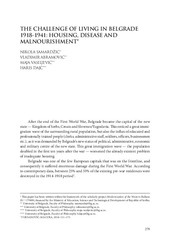| dc.contributor | Esteves Soares, Carolina | |
| dc.contributor | Rufino, Carolina | |
| dc.contributor | Isaac, Francisco | |
| dc.contributor | Malheiro Magalhães, José | |
| dc.creator | Samardžić, Nikola | |
| dc.creator | Abramović, Vladimir | |
| dc.creator | Vasiljević, Maja | |
| dc.creator | Dajč, Haris | |
| dc.date.accessioned | 2022-08-08T13:01:27Z | |
| dc.date.available | 2022-08-08T13:01:27Z | |
| dc.date.issued | 2018 | |
| dc.identifier.isbn | 978-989-8970-07-7 | |
| dc.identifier.uri | http://reff.f.bg.ac.rs/handle/123456789/3781 | |
| dc.description.abstract | After the end of the First World War, Belgrade became the capital of the new
state — Kingdom of Serbs, Croats and Slovenes/Yugoslavia. This enticed a great immi‑
gration wave of the surrounding rural population, but also the influx of educated and
professionally trained people (clerks, administrative staff, soldiers, officers, businessmen
etc.), as it was demanded by Belgrade’s new status of political, administrative, economic
and military centre of the new state. This great immigration wave — the population
doubled in the first ten years after the war — worsened the already existent problem
of inadequate housing.
Belgrade was one of the few European capitals that was on the frontline, and
consequently it suffered enormous damage during the First World War. According
to contemporary data, between 25% and 33% of the existing pre‑war residences were
destroyed in the 1914‑1918 period.
Therefore, after the end of the war, Belgrade experienced a huge influx of immi‑
gration. The capital’s population was 112,000 in 1919 and 314,000 in 19392
. This was
not only witnessed in Belgrade, however. All other major urban centers of the newly
established Kingdom of Serbs, Croats and Slovenes were subjected to a similar reality.
It could be argued that this was actually a pan‑European trend, considering that all
other major cities of the Continent were subjected to a similar immigration influx.In Belgrade, the disparity between the number of immigrants and the quantity of
available apartments led to situations where newcomers were lodged in staircases,
hallways, vestibules and even tents. These developments led to an abrupt increase of
the building activity. During the following decade, two peaks can be observed: the
first one happened between 1926−1928, while the second encompassed the 6 January
Dictatorship of the King Alexander 1930−19324
. During these intervals, 13.21% (1927)
and 12.5% (1932) more buildings have been constructed. | sr |
| dc.language.iso | en | sr |
| dc.publisher | CITCEM – Centro de Investigação Transdisciplinar Cultura, Espaço e Memória, Porto. | sr |
| dc.relation | The Modernization of the Western Balkans | sr |
| dc.rights | openAccess | sr |
| dc.rights.uri | https://creativecommons.org/licenses/by/4.0/ | |
| dc.source | Phármakon: Do Combate da Enfermidade à Invenção da Imortalidade | sr |
| dc.subject | Health Sciences | sr |
| dc.subject | Housing | sr |
| dc.subject | Serbian history | sr |
| dc.subject | History of Belgrade | sr |
| dc.subject | Tuberculosis and Infectious Disease | sr |
| dc.subject | Living History | sr |
| dc.subject | Infectious Diseases | sr |
| dc.subject | 20th Century | sr |
| dc.subject | Social Housing | sr |
| dc.subject | Minorities | sr |
| dc.subject | Tuberculosis | sr |
| dc.subject | Beograd | sr |
| dc.subject | Sífilis congénita | sr |
| dc.title | The challenge of living in Belgrade 1918-1941: housing, disease and malnourishment | sr |
| dc.type | bookPart | sr |
| dc.rights.license | BY | sr |
| dc.rights.holder | CITCEM – Centro de Investigação Transdisciplinar Cultura, Espaço e Memória, Porto. | sr |
| dc.citation.epage | 294 | |
| dc.citation.spage | 279 | |
| dc.identifier.doi | 10.21747/978-989-8970-07-7/pha | |
| dc.identifier.fulltext | http://reff.f.bg.ac.rs/bitstream/id/8858/THE_CHALLENGE_OF_LIVING_IN_BELGRADE_1918.pdf | |
| dc.type.version | publishedVersion | sr |

